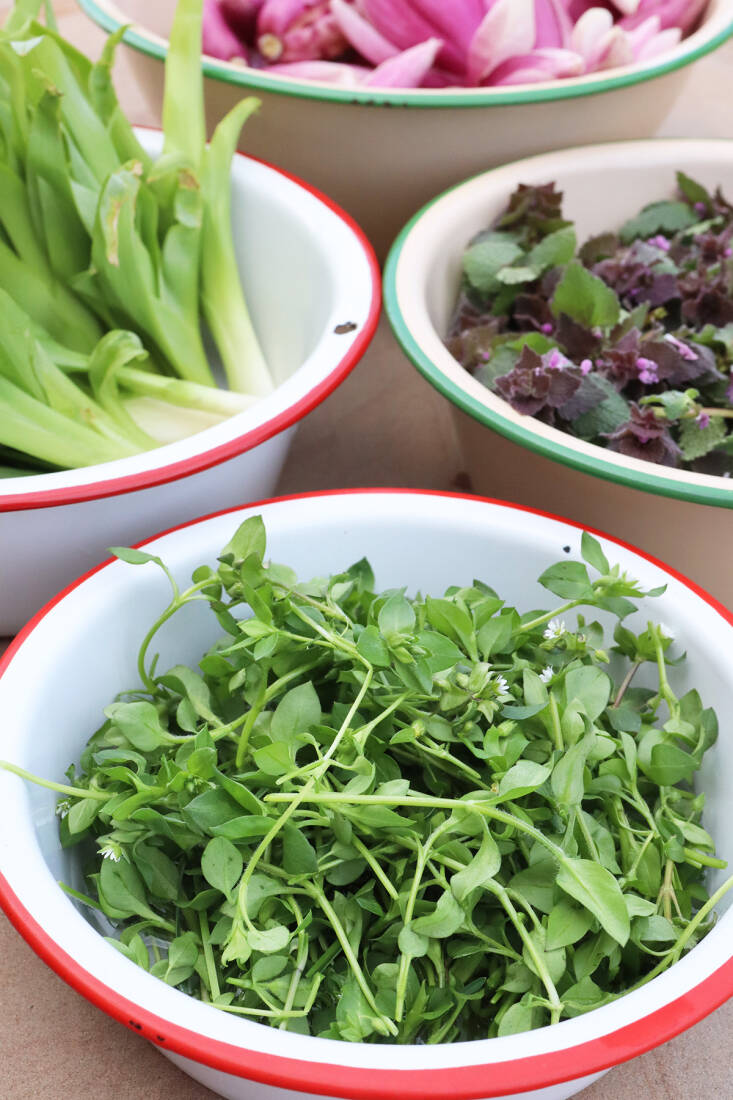I first met chickweed under an evergreen hedge in Bloemfontein, South Africa. It must have been springtime in that cold, winter-dry city, because the chickweed was lush, abundant, and tender. It smelled fresh and felt cool as I collected it as a green treat for our bantam hen and guinea pigs at home. I was five years old, at loose while my mother played tennis on the court hemmed by the hedge. Fast forward a few decades, and across two hemispheres, and I am collecting chickweed again—this time, to feed humans. The diminutive plant is easily trampled underfoot, but it is a shame to squash or kill such good food (also relished by bees). It is a compelling green vegetable, and tastes effervescently of spring.
Photography by Marie Viljoen.

Dom Perignon probably never really said that he was drinking the stars when he took a sip of fortuitously fizzy Champagne. That was an early example of marketing spin. But that spin would benefit the lowly lawnweed, Stellaria media. The chickweed genus is named for stars (stella = star), and the tender edible is brilliant with constellations of them in early spring. It’s tiny, five-petaled flowers help identify the plant, whose leaves taste like the scent of freshly-shucked cornsilk, a flavor that is vital and versatile.

Where I live in Brooklyn, New York’s USDA Zone 7 (-ish, thanks to urban microclimates), chickweed can appear as early in the year as February. In milder, moist regions, it is a winter weed, most conspicuous in cool, wet seasons. The Eurasian native, now at home all over the world, shuns heat and humidity. Sometimes, in a cool, damp autumn, it will reappear briefly.

Early in the season chickweed’s habit is prostrate and dense.

In full sun chickweed tends to remain mat-like, but in shade the plants can grow up to 12 pliant inches tall if they have enough moisture. By mid-spring those stems are lankier, the leaves are smaller, paler, and more spaced out, and its habit is defined more by copious seed capsules (beloved by birds), rather than blooms.


I feel rich whenever I collect chickweed. It’s the rare leafy green with striking flavor, and it feels strange and lucky to be gathering for free what could sell for substantial amounts at green markets (and occasionally, it does, when it meets a farmer with foresight).

How to eat chickweed: Add the softest leaves and stems raw to salads and spring rolls, where their delicately nutty taste will be appreciated best. Steam a mass of the tender stems and leaves and bake with eggs and cream in a custardy quiche, or add to omelettes and frittatas. In South Africa lovers of morogo and imifino (mixed, wild, cooked greens) will pounce on this prostrate plant and add it at the very end to the pot, draping it as a loving flourish over the other cooked greens.



How to collect tender chickweed: To save yourself time and a Sisyphean sorting back in the kitchen, collect only the tender stems of chickweed. If you can pinch a stem in two easily between thumb and forefinger it is soft enough to eat entire—raw or cooked. Early in the season that will be the whole stem. Later, cut the stem higher, leaving the tougher base; but when the leaves appear smaller and more spaced out on stems, things become fibrous, fast. At a glance, when the whole plant begins to pale from a rich green, the lanky stems are good for chickens, but not so much for us.

Chickweed mayonnaise
Makes 1 cup
This delicately aromatic, cornsilk-tasting, and easy mayonnaise (use store-bought or make your own) is delicious slathered across cold, boiled new potatoes. I like to skewer them—on dry mugwort sticks—and chill them, for picnic-fare. But they’re great tossed in a bowl, as a classic side-dish with feral twist.
- 4 oz fresh, tender chickweed, washed
- 1 cup prepared mayonnaise
Bring a pot of water to a boil. Plop the chickweed into it. When the water comes to a boil again, cook for another 1 minute. Drain at once and douse in cold water. In your hands, squeeze out all the excess moisture from the chickweed. Now roll it up in a clean kitchen towel to press out the last moisture. Unwrap, untangle the compressed greens, and chop them exceptionally finely. In a bowl, combine the chickweed with the mayonnaise. It keeps well in the fridge for up to a week.
Serve with boiled eggs, boiled potatoes, asparagus, or spread across sandwiches before topping with slices of cucumber.
See also:
- Tree to Table: The Many Ways to Enjoy Magnolias
- Field Garlic: A Sustainable Alternative to Ramps
- Make the Most of Your Greens: A Recipe for Leafballs








Have a Question or Comment About This Post?
Join the conversation